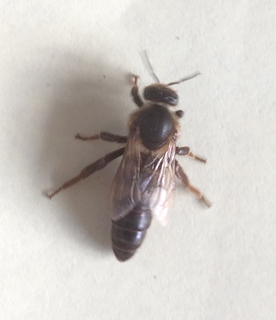 Another month of warm (for March!), sunny weather and the bees are loving it! They are all working like billy-o to bring in as much nectar and pollen as they can to feed their burgeoning nurseries and are continuing to expand rapidly ready for the season ahead. As I said I was planning to last month, I have by now transferred all feeding from solid candy blocks to contact feeders of liquid 1:1 sugar syrup and the bees have been taking it down into their brood boxes voraciously – and the blackthorn is flowering!! All very good news.
Another month of warm (for March!), sunny weather and the bees are loving it! They are all working like billy-o to bring in as much nectar and pollen as they can to feed their burgeoning nurseries and are continuing to expand rapidly ready for the season ahead. As I said I was planning to last month, I have by now transferred all feeding from solid candy blocks to contact feeders of liquid 1:1 sugar syrup and the bees have been taking it down into their brood boxes voraciously – and the blackthorn is flowering!! All very good news.
Except, I was walking through the apiary last week when I realised one of my colonies (in the polystyrene hive) was not flying as strongly as it had been, nor as strongly as the other hives. This prompted me to have a look inside, even though there was a chill breeze blowing that day. I assumed either laying workers (who would have developed after the loss of their queen through old age or some mishap or other) or a drone-laying queen (that is, one who had run out of sperm through poor or inadequate mating).
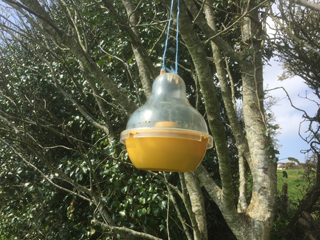 Either way, the colony was doomed unless something was done, whereas if I opened the hive to take a look the bees had two chances – either of dying (which they would do with no intervention) or of surviving by my helping them through their crisis. I very quickly found that there was very little brood, and on only one frame. Also, that the brood pattern, whilst good (that is, in a well-defined circle), consisted solely of drone pupae, together with larvae and eggs (presumably also drone only). This confirmed my suspicion of a drone-laying queen, so all I had to do now was find her!
Either way, the colony was doomed unless something was done, whereas if I opened the hive to take a look the bees had two chances – either of dying (which they would do with no intervention) or of surviving by my helping them through their crisis. I very quickly found that there was very little brood, and on only one frame. Also, that the brood pattern, whilst good (that is, in a well-defined circle), consisted solely of drone pupae, together with larvae and eggs (presumably also drone only). This confirmed my suspicion of a drone-laying queen, so all I had to do now was find her!
I expected to find her on that particular frame, with her brood, but she wasn’t there. She was however, on the next frame, so I inveigled her into entering my queen cage which I had ready – and in she went. So easy, I couldn’t believe it! I don’t know what happened then but somehow I managed to drop my hive tool, and also the still-open queen cage, onto the tops of the brood bars of the brood chamber! The queen escaped to what I thought was over the edge of the adjacent comb but find her I could not!
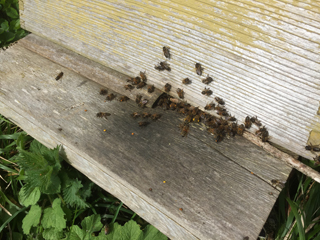 I went through the combs twice looking for her, but to no avail. She was obviously frightened by what had happened and had disappeared into the darkest recesses of the hive to escape my attentions. Ah well! Nothing for it but to come back the next day and try to find her again, as it was important that she was removed and replaced as soon as possible whilst there were enough bees present to make the whole manipulation viable. I closed the hive up and very dejectedly made my way back to the house, with some bees still on my bee-suit, even though they had been as calm as any beekeeper could wish during my intervention.
I went through the combs twice looking for her, but to no avail. She was obviously frightened by what had happened and had disappeared into the darkest recesses of the hive to escape my attentions. Ah well! Nothing for it but to come back the next day and try to find her again, as it was important that she was removed and replaced as soon as possible whilst there were enough bees present to make the whole manipulation viable. I closed the hive up and very dejectedly made my way back to the house, with some bees still on my bee-suit, even though they had been as calm as any beekeeper could wish during my intervention.
Just outside the back door I thought it would be wise if I brushed off the bees that were on me, otherwise my wife would be panicking about me bringing flying bees into the house! There were three on my left leg and I was about to brush them off when – hold it! Was that the queen? And yes, it was! She had somehow landed on my bee-suit, not in the hive, and was hitching a ride back to the house to her demise! I put her back in the queen cage, took her into the house, and took a photograph of her, as you can see here. I then took her outside and squashed her, poor thing.
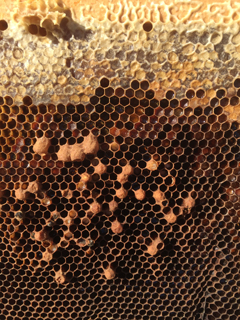 Students say to me sometimes “How can you kill queens when you obviously love your bees as you do?” Well, it is for the benefit of the colony. That colony would die if I left the queen to carry on as she was. She could only lay drone eggs, so there would be no workers left in the hive to gather food and water for themselves and their young once the workers that were there had died naturally (whilst the workers are bees that hatch from fertilised eggs, the drones come from unfertilised eggs – the only type of eggs this queen was now able to lay).
Students say to me sometimes “How can you kill queens when you obviously love your bees as you do?” Well, it is for the benefit of the colony. That colony would die if I left the queen to carry on as she was. She could only lay drone eggs, so there would be no workers left in the hive to gather food and water for themselves and their young once the workers that were there had died naturally (whilst the workers are bees that hatch from fertilised eggs, the drones come from unfertilised eggs – the only type of eggs this queen was now able to lay).
What I had in mind was to remove the old queen (now done) and place a frame of eggs from another colony in the hive so the bees could raise a new queen. Whilst it was still early in the season for queens to be able to mate, mainly because of a paucity of drones, if my efforts failed there would still be time to try with a second frame of eggs after two weeks, as the bees would raise worker bees on the eggs that were not used for queen rearing.
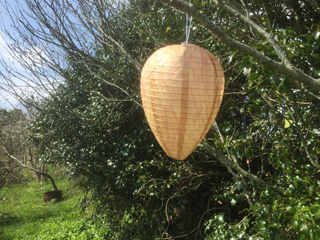 So the following day (as it was quite chilly by the time I got back to the house with the hitch-hiking queen!) I took a comb of eggs and larvae from the edge of the brood nest in another colony, removed the comb containing the drone brood from the poly hive, and placed the comb of eggs where the drone brood had been. I will check this weekend to see if any queen cells are being drawn and then, if all is well, leave them to it, though keeping an eye on the weather when it is time for the queen to take her mating flight.
So the following day (as it was quite chilly by the time I got back to the house with the hitch-hiking queen!) I took a comb of eggs and larvae from the edge of the brood nest in another colony, removed the comb containing the drone brood from the poly hive, and placed the comb of eggs where the drone brood had been. I will check this weekend to see if any queen cells are being drawn and then, if all is well, leave them to it, though keeping an eye on the weather when it is time for the queen to take her mating flight.
I don’t know what happened in last month’s blog but several photographs of very active hives a video of one of them, and pictures of home-made Asian Hornet Traps did not appear in the RoL magazine. The gremlins must have been at it again, but to make up for the omission I am including the photos again in the hope that they get through this time.
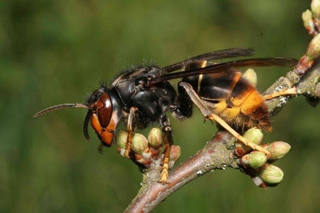 The Asian Hornet queens, if any have over-wintered in the UK, will be coming out of hibernation any time now (like the queen wasps, of which I have killed I don’t know how many), so we are putting out monitoring traps for them primed with beer and sugar. We don’t want to kill them – we want to capture them and confirm they are actually Asian Hornet queens before allowing the NBU to dispose of them. I have one in use supplied to me by the National Bee Unit (the yellow one, pictured, a modified version of those on sale as wasp/hornet traps in garden centres).
The Asian Hornet queens, if any have over-wintered in the UK, will be coming out of hibernation any time now (like the queen wasps, of which I have killed I don’t know how many), so we are putting out monitoring traps for them primed with beer and sugar. We don’t want to kill them – we want to capture them and confirm they are actually Asian Hornet queens before allowing the NBU to dispose of them. I have one in use supplied to me by the National Bee Unit (the yellow one, pictured, a modified version of those on sale as wasp/hornet traps in garden centres).
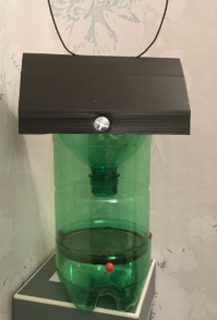
Try one yourself. Or make one using an old lemonade bottle – the plans can be found on-line if you Google “Asian Hornet Trap”. They are very easy to make and will give us extra opportunities to spot the pest should it raise its head above the parapet again,
Finally, that time of year is approaching rapidly when the bees will be wanting to swarm. If you see a swarm, either contact me directly (not by email, the swarm will be long-gone otherwise!) or log on to the CBKA or BBKA websites, go to the section on Swarms and type in your post-code. You will then be shown a map of Swarm Collectors in your immediate area and you can contact them directly. Any problems/queries, let me know – but Asian Hornets and honeybee swarms are what you need to be looking out for over the next few months. I’ll keep you updated on any developments.
Colin Rees – 01872 501313 07939 971104 – colinbeeman@aol.com
